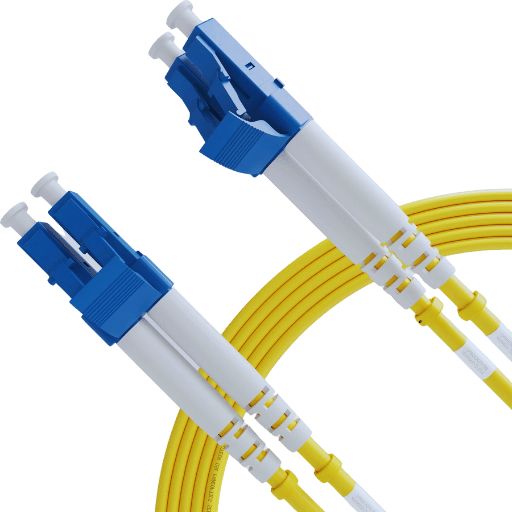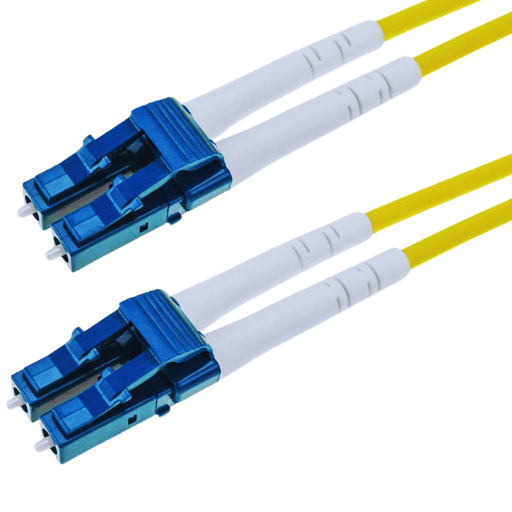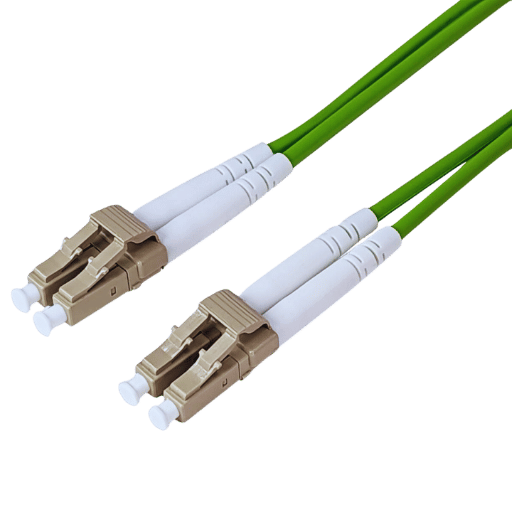Fiber optic patch cables are essential parts within the sphere of highly speedy transfer and networking. More specifically, the term LC to LC refers to those cables where both ends are terminated with LC connectors. These cables are famous for their accuracy, being small in size, and outstanding performance, which makes them suitable for use in densely populated areas in data centers and telecommunication use. As people’s yearning for quicker and more trustworthy data waters increases, so too does the necessity to comprehensively apprehend the details surrounding fiber optic patch cords. This article intends to explore all the major aspects of LC to LC cables, including their use, characteristics, deployment strategies, and best practices to configure them for successful operation and prolong deployment in many areas.

An LC to LC fiber patch cable, or LC patch cords, are standardized cables that have LC connectors on both ends. These connectors are preferred due to their small size and accurate design which enables high-density packing and effective space use within network environments. The cables are light-framed and available in single-mode and multimode variations depending on the distance or bandwidth strength needed in the fiber optics network. These cables enable communication by means of light pulses.
The Lucent Connector, commonly referred to as the LC connector, is small in size, and its design includes a latch on a push-pull configuration, which ensures secure connections. It was developed in response to an increasing need for dense connectivity in complex networking systems. Because of its compactness, the LC connector is most suited for applications that must conserve spaces like data centers. Its features include a ferrule diameter of 1.25mm, which is half the diameter of the ST and SC connectors, and this makes it appropriate for use in areas requiring advanced networking capabilities.
Fiber optic technology is normally divided into two types – single mode and multi-mode, depending on its intended use and the conditions it is supposed to work under.
Depending on the particular distance and data rate, as well as budgetary considerations, one or the other type is selected as each of the communication types possesses its respective fiber optic advantages.
Duplex fiber optic cables are primarily used in situations that necessitate two way communications simultaneously. This serves a critical role in systems where data has to be sent and received. These cables are widely utilized in worldwide telecommunication systems to facilitate the transfer of signals over long distances. In data centers, for instance, duplex cables are highly beneficial since they’re spiritedly coupled to fiber ports to serve high-traffic routers and servers to avoid congestion. They also allow applications that are bandwidth and stability demanding such as video conferencing and cloud applications. Lately, the telecommunication market has been booming, thanks to the rise of internet demand and the expansion of 5G networks that further increased the demand for duplex cables. Such advancements allowed for wider deployment of fiber optic networks notably increasing the industry?s versatility across a number of sectors.

Singlemode fiber cables are essential in telecommunications today because they can carry transmissions over long distances with little loss. This applicability utilizes an operating wavelength of 1310nm or 1550nm, where the optimal compromise between attenuation and dispersion occurs. This specificity is necessary to ensure signal retention over wide area networks. The singlemode fiber has a core diameter that is less than that of multimode fibers, approximately 8 to 10 microns, which allows only one mode to propagate. This characteristic dramatically diminishes the modal dispersion that is typically associated with multimode fibers, hence improving the bandwidth and the distance over which transmissions are done.
In the context of multi-urban and intercontinental network deployments, single-mode fiber seems to be crucial because of its remarkable ability to do distance. For instance, singlemode fibers can cover distances of between 100 kilometers or greater with no signaling repeater which is necessary for effectiveness in cost in large networks. Recent statistics indicate with the widespread supply of data globally, the adoption of the single-mode technology will register an average of about 7% increment each year, which depicts great support not only for traditional telecom services but even new technologies in the area of 5 G and IoT as well as high-speed broadband access. To sum up, single-mode fiber should be a key element for the 5th generation networks in terms of speed and efficiency, but even more importantly, it should be regarded as the basic substance in the telecommunication backbone of any civilization.
Among various fiber optics topologies, LC-LC connections are one of the most popular types of connections that utilize Lucent Connectors (LC). The compact design of the LC connector, which measures 1.25mm ferrule, allows for high-density configurations which is suitable for a number of applications, including data centers and telecommunications closets, which need many connections within a small area. Its push-pull latching mechanism guarantees a secure lock to ensure increased reliability against interface separation, which would compromise inter signal interference. The LC connector is also designed to be pushed or pulled out so that it can be easily fitted and removed from position, thereby requiring less downtime during the maintenance session. Moreover, It also has the ability to work with both singlemode and multimode fibers which broadens the scope of applications it can be used for. Since businesses have a greater focus on saving space and ensuring that the network is operational without a lot of problems, it became critical to fit LC-LC connectors for these tasks.
Insertion loss in LC to LC connects describes the loss of power of the signal due to the installation of a connector into a fiber system Lc connector. As for LC-type connectors, the insertion loss per connection will roughly range from 0.1 dB to 0.3 dB, depending on the quality of the connector and the circumstances of its installation. It is caused by, for example, different parts misalignment, the fiber’s end faces being imperfect, and the presence of dust or debris on the connectors. However, in view of recent developments in the area of fiber optics, improved industrial processes and increased control requirements were introduced, which made it possible to lower the values of the average insertion loss and improve the overall performance of the network. Furthermore, the users of such parts also adopted better connector polishing and closer connector design pinout. This attention to detail is particularly important in high-speed data communications networks since even a fraction of a decibel loss could affect the overall performance of the Network and the system efficiency.

There are several crucial differences that have an impact on the overall network performance, expansion capabilities, and cost efficiency when deciding between singlemode OS2 and multimode fiber optic cables:
Core Size:
Distance and Bandwidth:
Wavelength:
Application Environment:
Cost:
Attenuation and Dispersion:
When these issues are addressed, managers and engineers in the field of networks are well placed to choose optical fibers that suit their infrastructure the best in terms of operation and economics.
Singlemode OS2 fiber is ideal for distances over 2000m such as for metropolitan or wide area network (WAN) deployment. It is also suitable for telecommunications infrastructure due to its low attenuation and wide dispersion range and for cases where consistent and stable performance is crucial. In addition, OS2 provides the coverage and reliability needed on a campus or between data centers that are positioned far away from each other. However, the higher cost is something that ought to be factored in during budget planning, hence OS2 is more suitable where the need for advanced infrastructure is worth the investment.
Duplex Single-Mode systems outshine every aspect of telecommunication and data transfer as these consist of two optical fibers, single and one dual, to transmit and receive light signals, respectively. This separation makes it full-duplex, where both ends can communicate with each other simultaneously; thus, the maximum possible bandwidth is used, reducing the delay in communication. Although this has been accomplished through the single duplex mode fiber, which allows a maximum of 400 gigabits when duplexed together, thanks to the increased capacity of fiber networks required, this is or will soon suffice the demand. The single mode fiber aristocratically retains its low values of attenuation, which measure at a rough flattening figure of 0.4 dB/km, which in turn results in the retention of the signal across vast distances, and there is also the factor of metro, long-haul, and backbone networks that improve this. Adding on, they have the least amount of interference and cross-talk that allows high signal integrity to be maintained while data transmission can be performed efficiently. However, looking towards the future and expanding the infrastructure in the present network environment has the advantage of being able to do so and not having to go through a rigorous overhaul.

Standard one- and three-meter fiber patch cables have become more popular as they adapt to many networking environments. One-meter patch cables are often used in environments with limited space and require rack-to-rack or within a single rack patching. 3-meter patches are useful in environments where equipment needing connectivity is not in close proximity, or in cases where enclaves and devices across multiple racks are used, a little more distance needs to be covered.
All these lengths are offered in various fiber types, such as OM3, OM4, and OS2 fiber patch cables, to suit different network needs. These standard cables have an insertion loss of about 0.3 dB, which is important in making sure that loss of signal, particularly with patch cables, is kept to a minimum most of the time. These cables have a completely low bend sensitivity, which means that they will remain durable while maintaining the crucial principles of signal integrity in a high-density cable management area.
Additionally, these cables make use of LC, SC, and ST connectors, hence are compatible with standard network connections. These sockets were built with certain standards in place and are able to satisfy harsh network conditions. The fact that they are manufactured to certain sizes adds the advantage of having stock control in suitable packaging of network components. In connection, they also aid in the quick deployment of network infrastructures.
As modern networking technology sometimes needs custom solutions, custom-length fiber patch cords fulfill unique requirements that a standard length cannot conform to. Customization options offered by leading manufacturers and suppliers range from fiber type and connector type to lengths that are best suited to complicated cable management and distance specifications of advanced network infrastructures. Custom lengths increase performance by reducing excess cable slack, which helps reduce the potential for signal loss, thus increasing the efficiency of the network as a whole. Professional experts and various online assistance offered at the best-rated sites help make sure that every custom solution meets the market requirements in conjunction with particular project requirements, ensuring reliability and maximum performance at all times.
100G duplex networks are crucial in the modern era of fast-paced data exchange requirements for industries such as data centers, the telecommunication sector, cloud services, and financial services. The introduction of 100G network to a business organization greatly increases the bandwidth capacity and speed of transferring information which enables the organization be in a position to deal with large volumes of data. Recent statistics indicate that the total internet traffic globally is expected to be at the level of 4.8 ZB by 2022, and such requirements can be met by 100G technology. At the data centers, these networks allow quick transfer of information across different servers in a bid to optimize workloads and reduce latency. Service Providers use 100G networks to enable the deployment of 5G and future networks more reliably. Moreover, 100 G networks enable cloud providers to offer continuous, elastic services with high availability in order to keep up with the growing amount of digitization of business processes across the various sectors of industries. This shift to higher-capacity networks also provides for the requirements of the future, ensuring enhancement in performance and greater room for the development of technology and user demand.

Basic differences in materials and uses also have issues regarding safety and compliance with building regulations in the case of PVC and plenum-rated cables. Fiber optic cables that contain PVC are mainly used in non-plenum places are cheaper and do not have high fire resistance power. These cables, however, are dangerous as they do give off poisonous fumes when ignited. Plenum-rated cables, on the other hand, are made for spaces that require airflow, such as ducting and ceilings, and where there are greater fire protection requirements. These are formulated with low-smoke materials that have non or little harmful fumes when burnt. As your regulations are getting stiffer and firmer in order to ensure safety and security, the variance between installation costs and PVC and plenum cable selections are seen in sensitive areas.
Plenum cable selection entails careful and knowledgeable evaluation to ensure safety, legal, and functioning specifications. To begin, check the locality for building codes and other legal standards that regulate the installation and use of plenum-rated cables. Also, consider such composite materials as jacketing, which is required to be of low smoke and high flame propagation. This is further evidenced by the certification, which ranges from NFPA 262 to UL 910, which indicates the cable makes set safety standards.
As for the performance parameters, optical parameters bandwidth, attenuation, and insertion loss of prime importance to data-demanding networks should be evaluated. For instance, certain OM3 and OM4 plenum cables are ideal for use in a high-speed network since they have a higher bandwidth and lower attenuation, enabling data transfer over greater distances. The performance parameters against a certain criteria example would be Om4 plenum cables which have an average bandwidth of 2000 MHz.km.
Finally, cost calculations should not only include the initial cost estimates, but also the expected reduction in installation costs and repair expenses over the lifespan of the product. Thus the selection of the right plenum cables based on operational and safety characteristics of your plenum greatly reduces network inefficiency as well as compliance, making more economical and secure supply installations.
Riser-rated cables are necessary for vertical usage, such as cable routing between floors in a building, given their ability to retard flames. In accordance with the latest industry standards, such cables are also expected to pass even stringent flame tests such as UL 1666 so that, when fitted in a vertical shaft, they do not enable propagation of fire beyond a given distance. Riser cables are not compelled to pass as low an emission of the smoke test as plenum cables, thus enabling a great deal of latitude in the material used, which in turn lowers costs. More recent statistics show that installations of riser-rated cables cost 30% less on average compared to plenum-rated alternative systems while still being code and safe in riser spaces. In addition, they are extensively employed in the construction of buildings owing to good performance-to-risk ratio, unless those are of plenum-rated grade requirements. Thus, riser-rated cables are key in well-designed cabling systems, regardless of whether they are used in vertical cabling retrofitting or new structures, since these cables are designed to deliver the expected performance while complying with all the safety restrictions.
A: An LC to LC fiber optic patch cable is a cable that has LC type connectors at both ends. It is predominantly employed in data networking systems aiming to reduce signal loss while boosting data exchange speed.
A: LC single mode for instance, is a single mode fiber cable particularly useful for long distance communication due to the small core size which in effect reduces signal depletion. Much more speedy data transfer over short distances could employ OM3 cables, a type of multimode fiber patch cable that has a wider core diameter.
A: In interconnections situated in a rack-mounted equipment for instance: closely spaced equipment’s, then the widely used tip is around 1m which allows for easily patching versatile LC to LC duplex fiber optic patch cables.
A: LC duplex connectors are compact set of connectors that permit the joining of two fibers end-in-end in a very limited space thus enhancing its usability in dense networks. It is common to see them mounted on patch panels and high density networking devices.
A: OFNR means Optical Fiber Nonconductive Riser, which is a type of cable employed in vertical riser shafts. LSZH stands for Low Smoke Zero Halogen, a type of cable that does not burn or give off smoke and emits no halogens when burning; making sure that the installations done are much safer.
A: Duplex fiber optic patch cables are used for interconnection of network devices in areas where connections have to be temporally made for example Ethernet and Gigabit Ethernet. They have the capability of transferring information at both ends thereby improving the transmission over the network.
A: A fiber optic patch cord should be visually inspected and subsequently its insertion loss along with other parameters should be tested in order to avoid any performance negative effects. This ensures that the patch cord is compliant and will be able to perform the tasks without losing a significant percentage of signal efficacy.
A: OS2 cables are designed as single mode fibers and can be utilized in a space that requires the transmission of data over long distances. They are designed for both outdoor and indoor placement, and are equipped with high speed capabilities and low attenuation over large distances.
A: Fiber jumpers are short fiber optic cables within a fiber optic network that connect patch panels to other devices. It is used as a temporary or permanent connection to help in the organization and management of data center and telecom room cabling.
A: SFP modules that are sometimes called SFP+ are used in equipment such as network switches and routers, specifically as transceivers. SFP modules are designed to connect through LC to LC fiber optic patch cables in order to provide interfacing for various types of fiber and copper with network devices, enabling more advanced programming and flexibility in the network design.